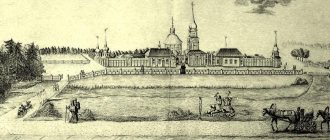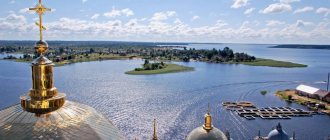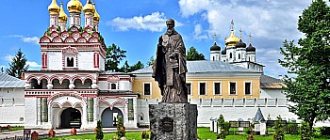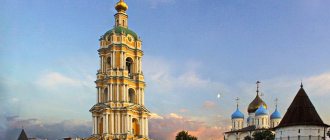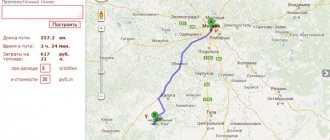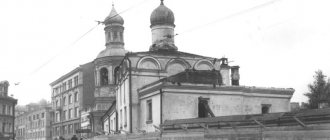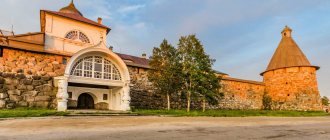The Alexander-Svirsky Monastery is one of the Orthodox spiritual centers operating in the Leningrad region. The men's monastery, regularly visited by pilgrims, travelers and tourist groups, is located in the village of Staraya Sloboda, 21 km from the town of Lodeynoye Pole. The remoteness of large settlements, virgin nature and the picturesque shore of Lake Roshchinskoye create a unique atmosphere of peace and harmony, promoting the awareness of spiritual truths and priorities.
View of the monastery from the shore of Lake Roshchinskoye, © Δημήτριος
Description of the Alexander-Svirsky Monastery
The Orthodox monastery, which includes famous architectural monuments of the 16th-17th centuries, was founded by Alexander Svirsky (1448-1533) at the end of the 15th century in the Olonets region (formerly Korelsky Land). At that time, these places were surrounded by dense forests and pagan settlements. The saint, now revered as a saint, quickly gained disciples and followers from among the indigenous population. The fame of the pious monk, which reached the most remote corners, attracted monks and lay people in need of prayerful help to his place of residence.
Even during the life of the Monk Alexander, two territorially separated complexes were formed in the monastery, connected by a path trodden along the lake:
- Trinity - at the fraternal cells;
- Preobrazhensky - next to the monastery cemetery.
Alexander-Svirsky Monastery in the 18th - early 19th centuries. called "Northern Lavra". He controlled about 30 monasteries and local deserts (remote monastic settlements).
The main part of the monastery's buildings was perfectly preserved, despite periodic raids by enemies and the difficult post-revolutionary period, when the relics of Alexander Svirsky were taken away, the sacristy was looted, ancient icons were destroyed, and the monks were dispersed or shot. In different years of the twentieth century, the territory and unique architectural monuments were used as a forced labor camp for prisoners, a nursing home, a psychiatric hospital and barracks.
The restoration of the Alexander-Svirsky Monastery began in 1997. The new inhabitants have made a lot of efforts, but today the complex is in need of major restoration efforts.
Church of the Intercession of the Blessed Virgin Mary with a refectory, © Masha Malinovskaya
Temples of the monastery
In the Trinity complex there are:
- Church of the Intercession of the Mother of God - built of stone in 1533–36. under Alexander Svirsky at the sacrificial funds of the Sovereign and Grand Duke of All Rus' Vasily III. The oldest (surviving) monastery church has a refectory;
- Trinity Cathedral - a stone structure erected in 1695–97. on the site of the wooden church of the same name, founded in 1508, and the stone church that replaced it in 1526. Inside the cathedral, frescoes created in 1709 have been preserved;
- belfry - a multi-span three-tiered structure with three tents appeared around 1646–48. Previously, the structure was wooden, with five tents;
- Church of St. John of Damascus - was built in 1716–18.
Three-tented belfry, © Lyudmila
On the territory of the Preobrazhensky complex there are:
- Transfiguration Cathedral - a wooden frame was erected in 1533, but during the period of the Polish-Lithuanian devastation (1618) it burned down. The stone structure was erected in 1641, and the chapel in the name of the founder of the monastery was erected in 1716. Later, the cathedral was reconstructed several times;
- Church of St. Zechariah and St. Elizabeth - added to the Transfiguration Cathedral in 1685;
- Gate Church of St. Nicholas the Wonderworker - located in the bishop's chambers above the entrance to the complex. Construction date unknown;
- Chapel of the Life-Giving Trinity - erected in 1791 on the foundation of a wooden church built by the founder of the monastery on the site of the appearance of the Most Holy Trinity to him;
- Chapel of Alexander Svirsky - located outside the Preobrazhensky complex. It was built in 1791 over a well, personally dug by the founder of the monastery and consecrated for the brethren;
- bell tower - erected in 1903-1904.
Gate Church of St. Nicholas the Wonderworker, © Masha Malinovskaya
In addition to the temples, the Alexander-Svirsky Monastery houses buildings - the bishop's, fraternal and cell buildings. Each of the two complexes is surrounded by walls. You can enter through the gate. In the open areas there are wide paths, plaster vases with flowers, lawns, benches, and lamps.
Founder of the monastery
The Monk Alexander Svirsky was born into a pious peasant family in the village of Mandera, in the Ladoga forests on the Oyat River. The child begged from the Lord, named Amos, was born on June 28, 1448.
At the age of 19, his beloved son secretly left his parental home: his father and mother started talking about marriage, Amos dreamed of becoming a monk, so he left home on Valaam.
Having crossed the Svir River, he stopped to rest on the shore of a forest lake in the middle of a pine forest. The traveler remembered the stop: the virgin beauty delighted, from the depths of the soul, fervent prayer flowed easily and freely.
After 7 years, the novice took monastic vows with the name Alexander. Following their son, their parents took monasticism, after whose death Alexander went to a secluded island in the Valaam archipelago and lived there, in a narrow and damp cave, for 10 years, eating the fruits of the northern forest.
The fame of Alexander's holy life spread throughout the area, but he went further away, settling in a memorable place among a dense forest on the shore of a lake.
Relics of Alexander Svirsky
The main shrine of the monastery is the relics of its founder. Even in the most difficult times, accompanied by enemy invasions, looting and fires, no one dared to touch the incorruptible remains of the saint. However, in 1918, the relics of Alexander Svirsky were seized, opened, examined, taken out and placed in one of the anatomical museums. The exhibit was listed for a long time as “the mummified body of an unknown man.” It took a lot of time to find the incorruptible flesh and examine it, but some historians continue to express doubts about the veracity of the shrine.
The second discovery of the relics of Alexander Svirsky took place on July 30, 1998, which became a major event for the reviving monastery.
Frescoes, © Lyudmila
The Alexander-Svirsky Monastery houses several more shrines, including:
- place of the appearance of the Holy Trinity;
- place of the appearance of the Blessed Virgin Mary;
- a copy of the Shroud of Turin;
- icons and frescoes;
- holy springs of drinking water.
Alexander-Svirsky Monastery - official website
Shrines and relics
The main shrine of Alexander of the Svirsky Monastery, which attracts thousands of pilgrims here, is the holy relics of St. Alexander, kept in the Cathedral of the Transfiguration of the Lord. During the celebration of Trinity, the shrine is transferred in a solemn procession to the Holy Trinity Cathedral.
There is also a consecrated copy of the Shroud of Turin, delivered to the monastery in 2006 for the five-century anniversary of its foundation. This was one of 6 copies of the Shroud of Turin that existed in the world at that time. After a short period of time, this shrine became silent.
In 2013, the Alexander Svirsky Monastery received a donation from the Odessa diocese of an ark containing pieces of 26 shrines, among them holy relics and pieces of sacred objects: the manger of the baby Jesus, the tunic of St. Joseph, etc.
The holy spring located at the entrance to the Preobrazhenskaya part of the monastery also belongs to the shrines of the Svirskaya monastery.
Hotels near the Svirsky Monastery
The Staraya Sloboda hotel is located 10 minutes from the complex. Guests can enjoy comfortable rooms with private bathrooms, refrigerators and TVs. On site there is a restaurant, playgrounds, an equestrian club, parking and a sauna. Free Wi-Fi and bicycle rentals are available to everyone.
Hotel near the Alexander-Svirsky Monastery on the map
Located a 5-minute walk from the monastery, the pilgrimage hotel offers shelter and food in the best hospitable traditions. Living here is subject to certain rules and responsibilities.
The heyday of the monastery
The Alexander-Svirsky Monastery grew quickly, the place became abundant and crowded. The monastery among the pristine forests became so famous that people not only from the surrounding villages, but also from the northern capital came to the fairs held near the walls of the monastery.
The monks, following the strict rules, fervently prayed with incessant prayer. The novices and workers worked to improve the monastery. Famous people, princes and kings donated rich contributions to the monastery.
During the life of the Monk Alexander, Grand Duke Vasily III sent building materials and generous donations to the monastery. Ivan the Terrible did not forget the monastery either: he considered Alexander Svirsky a great miracle worker and sent icons, bells and a silver cross to the monastery.
The Monk Alexander was considered their intercessor by Tsar Fyodor Ioannovich and the family of Tsar Boris Godunov. Mikhail Fedorovich Romanov especially revered the saint. Peter I came to the monastery to pray and venerate the relics of Alexander Svirsky.
By the beginning of the 17th century, the Svirsk monastery had turned into the richest monastery in the north-west of Rus'. The monastery overcame numerous fires, devastation and disasters, restoring its former beauty and strength.
At the beginning of the 20th century, the monastery had 8 churches, a rich sacristy, expensive icon frames shone with precious decorations. An archbishop's see and a seminary were created at the monastery. 27 monasteries under the control of the Svir monastery .
There was a mill, icon painting, carving and carpentry workshops here. The pride of the monastery is its rich library and repository of ancient handwritten books. The monastery spent 11 pounds of pure silver to make the shrine of St. Alexander of Svir.
200 people of the monastery brethren were engaged in arable farming and haymaking, vegetable gardens and forests, kept 40 horses and 100 cows, and sold milk and vegetables.
The local population benefited from the monastery's generous charity. 40 orphans were raised in the monastery; poor residents of surrounding villages were treated in the monastery and given medicines free of charge.
Schedule of work and services
The monastery is open daily from 06:00 to 20:00. On Sundays and holidays - from 08:00 to 20:00. The temple in which the relics of St. Alexander Svirsky, you can freely visit from Monday to Saturday from 10:00 to 17:00, and on Sunday from 12:00 to 17:00.
Trinity Cathedral, © Masha Malinovskaya
Anyone can come to church services. Tourists and excursion groups are allowed to view churches and chapels only after the end of services. Additional restrictions may concern issues related to the internal routine of the fraternity.
Schedule of services in the Alexander-Svirsky Monastery
Svyatoostrovsky monastery
“This island is called differently,” notes Nikolai Andreevich. - Who are the Saints? Who is Tall. And then also - Old Valaam. They say it all started with him.
According to legend, there were once pagan temples on the Valaam Islands. Here, back in the last century, there were many caves, and rock paintings could be seen along the banks. It is curious that these majestic, harsh islands have always been a kind of ritual place - islands for contemplation, for communicating with other worlds, for reflection.
One of these mysterious green hills is now looming ahead of us, following the course of the boat. He first appears above the water as a distant dark mountain. Gradually this mountain begins to grow. Finally, it is clearly visible that these are separate islands. But it’s strange - as you approach, the highest island , which seemed completely black, begins to somehow brighten, glow in the sun, and, having seen it, you understand that sheer cliffs rise steeply from the water, only here and there on the top of the head covered with a dark cap of green forests.
We are approaching the island from its highest, northern side. At the top, on the rocks, you can see a dilapidated wooden platform with railings, pine trees above the cliff. From here you can clearly see that in this part of the island floating above the water there is also its own, local mountain. The boat goes along the rocks, goes around them and, where the shore slopes slightly more gently to the water, moors to a destroyed log pier. We climb up a steep rocky path, among pine trees with unusual twisted trunks. Nowhere except Valaam are there probably such twisted trees.
“These are the winds we have,” says the forester. — The pine trees are twisted like a corkscrew...
The blows of the wind are primarily borne by these pines, growing along the banks, above the cliffs. In the depths of the forest and at the top of the mountain, the severity of the forest is somewhat softened. The grassy slopes are brightly colored with flowers, and everywhere there are traces of ancient human habitation - the remains of a monastery monastery that existed here. All that remains of the monastery are a church made of huge hewn logs, old larches, and a grave lined with stones. A staircase overgrown with grass leads us to a cave built into a rock on the mountainside. There is a bench in front of the cave. It must be nice to sit here in silence and contemplate the greatness of the world. I wonder what those ancient hermits were thinking about on that rock above the lake?
Somehow you involuntarily try to imagine yourself in the place of the person who lived here and with mixed feelings you enter the cave - a tight crevice about a meter wide and several meters long. It's completely dark inside. Nikolai Andreevich strikes a match, and in the weak, wavering light we examine the decoration of this stone dwelling - a pin in the wall, on which there probably stood a candle, a stand for a book. Having gotten used to the darkness, you can notice a narrow gap in the rock - a window through which light comes. But still it is painful for a living soul in this cramped hole. With relief, we go outside and, just like the previous inhabitants of this cave, we sit on the bench in front of the entrance.
Mossy stone steps lead down to the lake from the cave. Another path, with dilapidated wooden railings, goes over the cliff. We go around the entire island , go down to our boat and, while sailing, for a long time do not take our eyes off the rocks remaining behind. It’s good to spend a day or several days on such an island. But they lived here alone for many years...
Isakov V.Z. Walks along Valaam / Vladimir Isakov. – M.: Soviet Russia, 1984. – 79 p. – (Writer and time). pp. 10-13. Chapter 2. On the lake.
Iskhakov told me that in those years he tried to visit and even live in a variety of places. For example, he lived on Holy Island and spent the night there in a cave.
Isakov V.Z. Walks along Valaam / Vladimir Isakov. – M.: Council. Russia, 1984. – 79 p. – (Writer and time). pp. 37-43. Ch. Red Monastery.
Visiting rules
Since the monastery belongs to a closed religious organization, when visiting it you must follow certain rules. It is not allowed to come in beach clothes or too revealing clothes, including shorts, breeches and miniskirts. Women are advised to cover their heads with a scarf and avoid trousers (in extreme cases, the lower part of the body can be wrapped in a piece of any fabric). It would be appropriate to turn off mobile phones when entering churches and chapels.
Photographs and videos on the territory, in churches and chapels are allowed only with the blessing of the clergy.
The following is strictly prohibited on the territory of the complex:
- smoke;
- drink alcohol;
- run;
- make noise;
- to swear;
- walk on the lawns;
- sunbathe and swim;
- enter residential premises and outbuildings.
Iconostasis, © Lyudmila
Excursions for groups can only be carried out with the blessing of the abbot of the monastery and accompanied by representatives of the pilgrimage service. The application must be sent in advance. More detailed information is posted on the official website of the Orthodox monastery.
The beginning of the Svir monastery
In 1508, during night prayer, the Divine Light shone around the hermit’s hut, and three light-like Angels appeared before him, commanding the monk to build a church and found a monastery.
The monk tremblingly asked what to name the church, and received the answer: “Beloved, as you see Him speaking to you in Three Persons, so build a church in the Name of the Father and the Son and the Holy Spirit, the Consubstantial Trinity.”
Soon hunters came across the monk’s hut, and the secret refuge became known. One of the hunters, Andrei Zavalishin, stayed with the monk and forever became his spiritual child. Those who wanted salvation and solitary prayer came to monk Alexander and settled nearby.
The monks worked and prayed together, Alexander prayed the most. That same year the wooden Trinity Church , and the monks insisted that Alexander become abbot of the monastery.
Saint Alexander, having become abbot, became even more humble - he wore rags, slept on the bare floor, and worked equally with everyone else. One day the steward asked the abbot to send one of the idle monks to chop wood. The monk, with the words: “I am idle!”, went into the forest himself to collect firewood.
Hegumen Alexander did not reproach anyone with a stern word, he gave all instructions in parables, constantly setting an example of humility and hard work for the brethren.
So in the remote Olonets region, in the virgin dense forests, a monastery was founded among the indigenous pagan population. Local residents - Karelians, Vepsians, Chuds - converted to the Christian faith, looking at the way of life of Elder Alexander, and came to the monastery for tonsure and prayer.
Metochion of the Alexander-Svirsky Monastery
Before the 1917 revolution, the monastery's courtyard was located next to the Yamsky market in St. Petersburg. Today this building houses a tuberculosis dispensary, and for the construction of a new courtyard another place was allocated at the address: lane. Chelieva, 10.
A small Church of the Nativity of Christ was erected on the territory, in which two shrines are kept:
- The Life-Giving Cross of the Lord with particles of important Orthodox relics;
- The Zhirovitsky Icon of the Mother of God is an exact copy given by the Dormition Zhirovitsky Monastery.
Official website of the Svirsky Monastery Metochion
Abbots
Abbots
- Alexander Svirsky (1506—1533)
- Isaiah
- Nicodemus (short time)
- Herodion (before 1545)
- Benjamin
- Afanasy Syandebsky
- Isidore (before 1572)
- Joasaph (until 1582)
- Dionysius (until 1608)
- Paisius (until 1613)
- Theodoret (before 1628)
- Abraham (until 1646)
- Alexander (until 1649)
- Savvaty (until 1660)
- Simon (before 1665)
- Joseph (until 1666)
- Macarius (Poluechtov) (until 1673)
Archimandrites
- Hermogenes (before 1699)
- Lawrence (until 1702)
- Cyril I (before 1705)
- Isaiah (before 1708)
- Theodosius (until 1715)
- Hilarion (until 1717)
- Alexander I (until 1719)
- Cyril II (until 1732)
- Vissarion (until 1738)
- Ephraim (before 1740)
- Benedict (until 1742)
- Seraphim (until 1748)
In 1748-1752. There was no archimandrite; the monastery was ruled by the governor, Innokenty.
- Andronik (1752-1759)
- Pachomius (until 1763)
- Barsanuphius (until 1763)
- Alexander II (until 1775)
- Irinarch (until 1780)
- Varlaam (until 1790)
- Parthenius I (Petrov) (1790-1800)
- Joseph (until 1816)
- Tobiah (until 1819)
- Parthenius II (to 1820)
- Macarius (until 1827)
- Barsanuphius (Morev) (until 1853)
- Ezekiel (until 1855)
- Pavel (Smirnov) (until 1869)
- Anthony (until 1870)
- Daniil (until 1872)
Viceroys
- Archimandrite Savvaty (1873-1878)
- Hegumen Innocent (1878-1883)
- Archimandrite Macarius (1883-1891)
- Hegumen Anthony 2015
Archimandrites
- Agafangel (December 21, 1891-1909)
- Evgeny (Trofimov) (1909 - executed 1918)
- Lukian (Kutsenko) (December 23, 1997 - October 2011) and. O. until July 19, 1999
- Mstislav (Dyachina) (from October 28, 2011) and. O. until March 16, 2012
How to get to the Alexander-Svirsky Monastery
The distance from the Northern capital to the village of Staraya Sloboda, where the monastery is located, is about 270 km.
Direct flight from St. Petersburg
From bus station No. 2, located in St. Petersburg on the Obvodny Canal embankment No. 36, bus No. 863 departs daily. Travel time is 5 hours. The schedule can be viewed on the website.
With a transfer from St. Petersburg
Bus No. 963 passes through the Lodeynoye Pole bus station on the route St. Petersburg - Pitkyaranta. After getting off at the stop, you need to transfer to bus No. 89/91, heading towards Pogo and Kandushi, and get to the village of Svirskoye.
You can get to the Alexander-Svirsky Monastery from St. Petersburg by electric train No. 6012/6014, departing from the Ladozhsky railway station. He will deliver to the station. "Lodeynoe field" Then you will need to transfer to bus No. 89/91 or a minibus that runs between the railway station and the monastery complex.
- Schedule of buses departing from the bus station in Lodeynoye Pole.
- Schedule of electric trains running from Ladozhsky station in St. Petersburg to Lodeynoye Pole.
The courtyard of the Alexander-Svirsky Monastery in St. Petersburg can be reached by public transport to the stops “st. Novoselov" or "st. Telman":
- by bus - No. 12, 97, 118;
- by minibuses - No. K-12, K-97, K-365, K-385;
- by trams - No. 7, 27, 39.
Poklonny Cross on the highway at the turn to Staraya Sloboda
By personal vehicle
The fastest and most convenient route will take a little more than three hours. From the ring road of St. Petersburg you need to turn onto the Murmansk highway (also known as the E-105, R-21, Kola highway) and get to the Poklonny Cross. Next, turn left to the village of Svirskoye. From here to Staraya Sloboda - only 6 km.
In addition to the methods described above, you can get to the Alexander-Svirsky Monastery from St. Petersburg as part of excursion pilgrimage groups.
Alexander-Svirsky Monastery: video
Restoration of the monastery
On June 29, 2009, the buildings of the Svir monastery were transferred to the monastery, repair work is still going on.
The well-groomed territory of the monastery is surrounded by a wall, strict and laconic in architecture. The pedestrian paths are paved with stone and there are benches for relaxation. On the lawns there is neatly trimmed grass, in the plaster lawns there are flowers everywhere.
The Alexander-Svirsky Monastery lives according to the rules. Each of the 32 inhabitants works to the best of their ability for the common benefit and receives what is necessary for life.
In St. Petersburg, at the Nativity Compound , there are workshops where they produce everything necessary for the revival and decoration of the monastery. People are engaged in icon painting, sewing, making ceramics and carpentry, and artistic wood carving.
In 2012, a bishop's choir was created in the monastery, where people with musical education sing. The monastery runs a Sunday school for adults and children. On Saturdays, lectures are held on topics of Orthodox doctrine. Classes for children - on Sundays.
Young people sing in the choir and stage plays on biblical themes. On holidays, children and teachers organize performances. The monastery hosts services, receptions for pilgrims, pilgrims and tourists.
Stop in Lodeynoye Pole
You can also stop in Lodeynoye Pole. The monastery is located 21 km. from the city.
The hostel is a hostel with amenities. We are happy to accept both single residents and families, as well as teams of workers. The dormitory has a shower, washing machine, and iron. One bed - 300 rub.
Tel..
Address: Lodeynoye Pole, st. Talalikhina, no. 3 (Garrison). Nearby is the Pyaterochka store. There is parking opposite the hostel.
